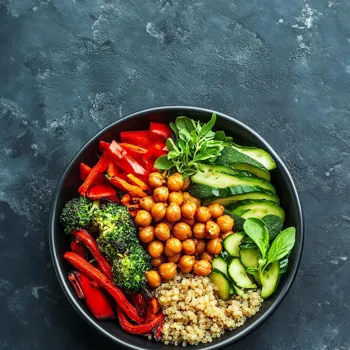Unlock the secrets to a balanced and healthy meal plan. Dive into 8 essential tips for nutritious eating!
Namaste, folks! In today's fast-paced world, grabbing a quick bite on the go often trumps sitting
down for a proper, nutritious meal. But, hold on a minute! What if I told you that creating a balanced and healthy meal plan doesn't have to be a chore?

It can actually be quite simple, fun, and a major game-changer for your overall well-being. A balanced diet is not just about shedding kilos; it's about feeling energized, boosting your immunity, and keeping those pesky health problems at bay.
So, let's dive into eight essential tips that will help you create a meal plan that's as delicious as it is good for you!
Know Your Nutrients: The A, B, C of Healthy Eating
First things first, let's talk about the building blocks of a healthy meal: macronutrients and micronutrients. Macronutrients are your carbohydrates, proteins, and fats – the big guys that provide your body with energy.
Micronutrients, on the other hand, are your vitamins and minerals – the tiny but mighty helpers that keep everything running smoothly.
Think of it this way: Carbohydrates are like the fuel for your engine, providing you with quick energy to power through your day.
Opt for complex carbohydrates like whole grains (think atta roti, brown rice, and oats) over simple sugars (like sweets and processed snacks). Proteins are the building blocks for your muscles, tissues, and enzymes.
Incorporate good sources of protein such as lentils (dal), beans, chickpeas (chana), paneer (cottage cheese), and curd (dahi) into your diet. Fats, yes, even fats, are essential! Healthy fats, that is. They help your body absorb vitamins, protect your organs, and provide you with sustained energy.
Choose sources like nuts, seeds, avocado, and olive oil. Do not use it to consume the deep-fried snacks available in the market, they have more oil percentage than other healthier ingredients.
Vitamins and minerals support nearly every process in your body, from boosting your immune system to keeping your bones strong. Load up on colourful fruits and vegetables to get your daily dose of these essential nutrients. Once you have grasped the basics, you can move onto the next step.
The key is to ensure you have a balance of all these, not one over the other.
Portion Control is Key: Plate it Right!
Okay, so you're eating healthy foods, but are you eating the right amounts? Portion control is crucial for maintaining a healthy weight and preventing overeating. A simple way to visualize this is by using the "plate method." Divide your plate into three sections.
Fill half your plate with non-starchy vegetables like leafy greens, broccoli, cauliflower, carrots, and bell peppers. These are low in calories and packed with vitamins and minerals. Fill one-quarter of your plate with a source of lean protein like lentils, beans, chickpeas, or paneer.
Remember that protein helps you feel fuller for longer, preventing those mid-afternoon cravings. Fill the remaining quarter of your plate with a source of complex carbohydrates like brown rice, quinoa, whole-wheat roti, or oats. Remember what we said about carbohydrates being your body's fuel?
Keeping to the plate proportion will provide the necessary carbohydrate intake.
Plan Your Meals Ahead: Be the Boss of Your Food!
Ever found yourself staring blankly into the fridge at 7 pm, wondering what to cook for dinner? This is where meal planning comes to the rescue! Taking a few minutes each week to plan your meals can save you time, money, and a whole lot of stress.
Start by making a list of your favourite healthy recipes. Consider the time you have available for cooking each day. On busy weeknights, opt for quick and easy recipes like dal-chawal or vegetable khichdi.
Think about making a menu of the whole week, and then decide which vegetables and other ingredients would be necessary for them. Also, before going on buying spree, do check what you already have. This will reduce the quantity and save money too.
On weekends, you can try more elaborate dishes that require a bit more time and effort. Once you have your meal plan in place, create a shopping list! Sticking to your list will prevent you from buying unhealthy impulse items that can derail your healthy eating habits.
Snack Smart: Curb Those Cravings the Healthy Way!
Snacking gets a bad rap, but it can actually be a helpful tool for managing your hunger and preventing overeating – as long as you snack smartly. Choose snacks that are packed with nutrients and will keep you feeling full and satisfied.

Avoid sugary snacks like biscuits, chocolates, and processed chips. Instead, opt for healthy options like fruits (apple slices with peanut butter, banana), nuts (almonds, walnuts, cashews), seeds (pumpkin seeds, sunflower seeds), yogurt (dahi), or a handful of roasted chana.
Planning healthy snacks in advance is key to avoiding unhealthy impulse choices. Keep a stash of healthy snacks in your bag, at your desk, and in your car so you always have a nutritious option readily available. You can also try some new things, like mixing fruits and nuts together.
These are also good for giving to children when they are returning from school.
Hydrate, Hydrate, Hydrate: Quench Your Thirst the Right Way!
Water is often overlooked, but it's absolutely essential for your health. Staying hydrated helps regulate your body temperature, transport nutrients, flush out toxins, and keep your skin glowing.

Aim to drink at least 8 glasses of water per day, and even more if you're active or live in a hot climate. Carry a water bottle with you wherever you go and sip on it throughout the day. Make water your go-to beverage.
Avoid sugary drinks like sodas and juices, which are loaded with empty calories and can contribute to weight gain. If you find plain water boring, try adding slices of lemon, cucumber, or mint to infuse it with flavour.
Other hydrating options include herbal teas, coconut water, and buttermilk (chaas). During the summer season, you can also eat water-based fruits like watermelons, muskmelons, etc.
Listen to Your Body: Tune in to Your Hunger Cues!
One of the most important aspects of healthy eating is listening to your body's hunger and fullness cues. We often ignore these signals, eating out of boredom, stress, or habit, rather than true hunger. Before reaching for a snack or a meal, take a moment to check in with yourself.

Ask yourself: Am I really hungry? Or am I just bored, stressed, or thirsty? If you're truly hungry, eat slowly and mindfully, paying attention to the taste, texture, and smell of your food. Stop eating when you feel satisfied, not stuffed.
Eating slowly allows your body time to register that you're full, preventing overeating. Remember, your body is a wise machine. And the best way to get healthy, is to listen to it.
AI Generated Content. Glance/InMobi shall have no liability for the content










